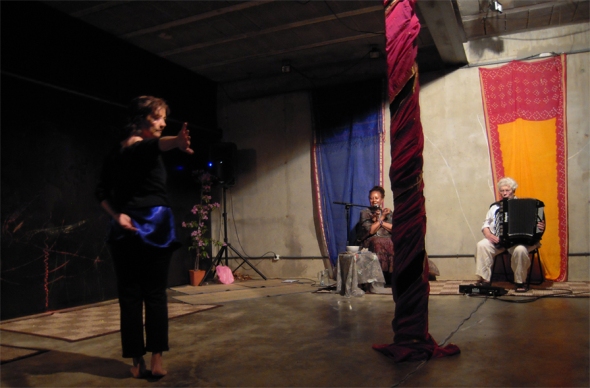Deep Listening Retreat
Posted: July 30, 2010 Filed under: Improvisación, Workshops Talleres | Tags: Camallera, Collaboration, Deep Listening, improvisation, performance Leave a commentA summer Sounding, Dreaming, and Listening with the whole body. Deep Listening is a wide and profound listening practice and philosophy developed by the composer Pauline Oliveros, who works in collaboration with the artist IONE and the performer Heloise Gold.
I lived a 20th Annual Retreat engaged in collaborations for performance, improvisations, and dreaming, while breathing fully the Spanish soundscape in Nau Coclea and connecting with all participants and the world that surrounds us. The atmosphere of Deep Listening nourishes deeply Sounding Underground: its conception, artistic and performative practice and research.
Thanks to all!
Improvisación "Escuchar y Recordar"
Posted: October 19, 2008 Filed under: Improvisación, talleres | Tags: improvisation Leave a commentHola! Aquí está su generosa colaboración en el día de la improvisación. No encontrarán todo lo que pasó (particularmente grupo 1 y 2) , pero traté de recobrar lo que la cámara capturó tanto en imagen como en sonido (a excepción del grupo 3, que está en puro sonido), para dar una idea.
Los invito a ver y escuchar. También los invito a comentar en general, y en particular dos aspectos:
1. De qué se trató este viaje colectivo?
2. Les parece interesante (u otra opinión) expresar y compartir sus memorias del paisaje sonoro del metro con la voz?
Mil gracias otra vez!!!
Ximena
Improvisation in Mexico
Posted: October 18, 2008 Filed under: Workshops Talleres | Tags: improvisation, workshops Leave a commentThese are four video documents of a sound improvisation that took place in the Centro Multimedia from CENART, in México City with participants in the project (Group 1 to Group 4). The purpose of this workshop was to know how participants create stories in sound, using their voices, while listening to sounds previously selected by them from their journeys. This experiment provides elements with which to develop interactive options, using sound and voice, for the web. For the researcher it is important to have these trials off-line, before establishing the on-line structure using remote networking.
The participants are listening to four journeys, through five loudspeakers strategically positioned. A server (the computer I am controlling) triggers each participant’s sounds following the journey structure (Street, Entrance, Tickets, Corridors, Platform, Carriage). Participants can record their voices through a client that first asks them to tag their memory and then starts to record. All participants have access to these recordings, and can play them back. At the same time, they are listening to the sounds of their journey, via the speaker closest to them. Apart from technical evaluations, I would like to know:
1. What was their collective journey about?
2. Do you find interesting (or another opinion) to share memories of metro’s soundscape with the voice?
Group 4 Group 3 Group 2 Group 1
If you are interested in watching these videos, please send a message to XAlarcon[at]dmu.ac.uk, and ask for a password. Although all volunteers have given permission to publish the video on the web, I would like to keep it private for participants and people with academic/artistic interest.
This setting was created with the collaboration of Dr. Peter Batchelor from MTIRC, an IOCT partner. In México this work received technical assistance from Dr. Ron Herrema also member from the MTIRC. Many thanks to both!
Improvisación “Escuchar y Recordar” en México
Posted: October 16, 2008 Filed under: Workshops Talleres | Tags: improvisation, workshops Leave a commentEste es un documento en video de una improvisación sonora que se desarrolló en el Centro Multimedia del CENART, Ciudad de México con participantes en el proyecto (Grupo 1 – Grupo 4). El objetivo de esta actividad de taller fue conocer cómo los participantes crean historias sonoras, con sus voces, mientras escuchan sonidos previamente seleccionados por ellos, de sus viajes en metro. Este experimento ofrece elementos para desarrollar opciones intreractivas, usando sonido y voz, en el Ambiente Sonoro Interactivo que se está diseñando. Para la investigación considero importante tener estas pruebas en un espacio real, antes de establecer la estructura on-line con networking remoto.
Los participantes están escuchando cuatro viajes, a través de cinco bocinas estratégicamente posicionadas. Un servidor (el computador que yo controlo) envía los sonidos de cada participante siguiendo la estructura del viaje (Calle, Entrada, Taquilla, Corredores, Andenes, Vagones). Los participantes pueden grabar sus voces a través de un “cliente” que pregunta primero por un tag (o palabra clave) antes de grabar la memoria, y empieza a grabar. Todos tienen acceso a estas grabaciones y pueden reproducirlas. Al mismo tiempo, ellos están escuchando los sonidos de su viaje, a través de la bocina más cercana. Aparte de evaluaciones técnicas, me interesa saber:
1. De qué se trató este viaje colectivo?
2. Les parece interesante (u otra opinión) la expresión de memorias del paisaje sonoro del metro con la voz?
Group 4 Group 3 Group 2 Group 1
Si usted está interesado en ver estos videos por favor envíeme un mensaje a XAlarcon[at]dmu.ac.uk, y le daré una contraseña. Aunque los participantes han otorgado permiso para publicar el video en la web, me gustaría tener esta información de manera privada para participantes y personas con interés académico y artístico.
Esta instalación fue creada con la collaboración del Dr. Peter Batchelor del MTIRC, un partner del IOCT . En México este trabajo recibió asistencia técnica del Dr. Ron Herrema miembro del MTIRC y con la colaboración del Centro Multimedia del CENART. Muchas gracias por su ayuda!



You must be logged in to post a comment.